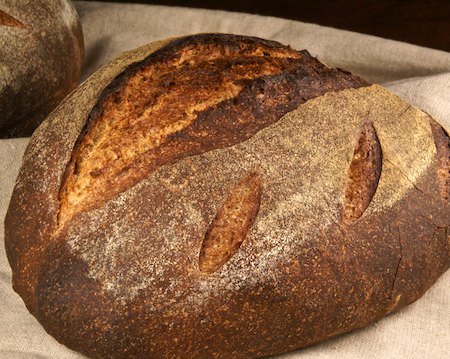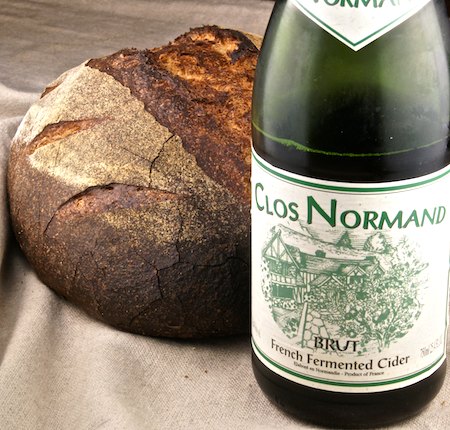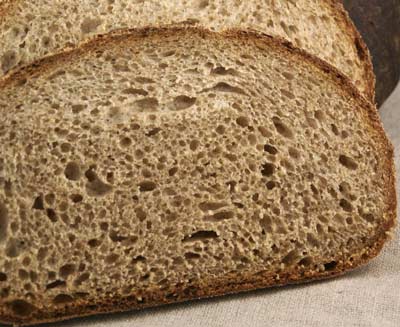
If you like assertively sour bread and a dark, flavorful crust, you will like this bread. If you don’t like one or both of those things, please skip it.
Although I started out thinking this bread would be an adaptation of the Normandy Rye from Nancy Silverton’s Breads from the La Brea Bakery, it turned out this bread didn’t want to be that. Instead it wanted to be more sour and more rye. Although at about 41% rye flour I suppose it qualifies as only a light rye, the flavor is not light at all.
The crust on this wants to get really really dark, and you should let it. The crust in the photo below looks like it is burned, but it isn’t. The sugars (which are in extra abundance here from the cider) have caramelized to give the crust a deep, sweet flavor that contrasts very nicely with the sour crumb.

Apple Cider Rye
Yield: 2 kg (2 large loaves)
Time:
- Mix: 30 minutes
- First fermentation : 2 hours
- Preshape, rest, and shape: 20 minutes
- Proof: 2 hours
- Bake: 45 minutes
Desired dough temperature: 80F
Ingredients:
- 578 g flour
- 277 g coarsely-ground whole rye flour (such as King Arthur Pumpernickel)
- 250 g fermented apple cider
- 282 g water
- 224 g mature 100%-hydration white starter
- 400 g mature 100%-hydration rye starter
- 20 g salt
- 20 g malted barley syrup (1 T.)
Method:
- In the bowl of a stand mixer with dough hook, combine the flours, water, cider, and starters. Mix in low speed until roughly combined, then cover the bowl with a linen and let rest for 20 minutes.
- Add the salt and barley malt syrup. Mix in low speed to combine. Adjust the water as needed to achieve a medium dough consistency.
- Continue mixing in low or medium speed to a low-medium level of gluten development. This might take about 3 minutes, but will depend on your mixer.
- Transfer the dough to a lightly oiled container. Cover and ferment at room temperature for 2 hours.
- Turn the dough into a lightly floured counter. Divide into two pieces. Preshape them into balls and let rest, covered, for 15 minutes.
- Shape the dough into tight balls, roll them to elongate them slightly, and place them, seam-side-up, on a lightly floured linen couche.
- Proof at room temperature, covered, for about 2 hours.
- Meanwhile, preheat the oven, with baking stone, to 500F. You will also need steam during the initial phase of baking, so prepare for this now.
- Just before baking, slash down the center of each loaf, then three smaller slashes, at an angle, on each side of the central slash.
- Once the loaves are in the oven, turn the heat down to 475F. Bake for 10 minutes with steam, and another 15 minutes without steam. Turn the oven down to 450F and bake another 10 minutes. Then turn off the oven and leave the loaves in for another 10 minutes, with the door ajar.
- Cool on a wire rack.

What an interesting recipe! Your loaf looks fantastic!
Cheers,
Rosa
Well, I am not sure until I tried it myself. In general I don’t like bread that is too sour. But my husband will love it. Thank you for the recipe Susan.
Cheers,
elra
wow a bread with cider and rye sure looks good to me, is it heavy?
Well it’s a good thing you got the Normand cider, now some good Camembert, but wait? Doesn’t this loaf want some apples? Doesn’t matter, looks good, no great, and well it’s one I will try to master, as soon as I get a second or two!
Happy Baking
Incredible loaf Susan. Always your breads are works of art.
So want to find that cider, to drink and bake with!
I can hear the bread singing…
Beautiful…
Nice loaves! and a great way to use cider (living in the west country in england, one is spoilt for choice when it comes to cider/’scrumpy’)
You mentioned the sourness of the bread. Is that perhaps because of the added malt syrup? I know that sounds weird – adding syrup should make it sweeter – but maybe it’s also the food of choice for the LB bacteria in the sourdough starter?
Susan, my mouth is puckering up just looking at the photo and reading the recipe. Foolish Poolish, great question!!!!
Okay, back to the kitchen, my break is over….
send bread, I need nourishment.
😉
Hi Susan, As soon as I saw this post I took out my Nancy Silverton book (literally falling apart from years of use) and decided to convert some of my regular starter over to rye using her method so that I can try this loaf. I was never a rye fan, but I’m beginning to use it more in my sourdoughs and pizza doughs and I might be ready for the full depth of rye flavor that this obviously has. Thanks!
Beautiful as always!!!!You make my happy…
What a beautiful bread! It looks right up my alley. Sour and crusty. Yes, yes, yes! So gorgeous, so yummy!
What a great colour! I love the idea of cider in the rye, I am a fan of sour bread.
I like to keep the kalamata olive brine for bread making, and other throw-aways like that. Makes for interesting variations!
Thanks for sharing this recipe. I just recently received a sourdough starter from a friend and have been enjoying making all sorts of things with it. This bread will join the “to bake” list!
This looks wonderful!
This looks absolutely fantastic! Can you tell me where to buy the hydration starters?
I’ve been playing with this recipe too lately. I’ll have to try your version of it. It’s an absolutely wonderful bread … tangy and flavorful.
I’ve been having trouble getting a nice bloom on this bread once in the oven. Suggestions?
Susan-
What a fantastic concept! I love the almost black color of the crust in that middle photo. Cider + rye + sour = my kind of bread.
-Siri
By the way-
Do you know of any decent substitutions for malter barley syrup? I’m not so sure it’s easy to come by here in Norway.
Would some type of molasses work?
I’m in awe. This loaf looks amazing. I can picture it on my table with a Norman soup, some cold cider and cheese…of course cheese.
Somehow I feel that the pale rolls that I just baked aren’t going to cut it tonight.
The fermented apple cider also sounds appealing even if I’ve never even seen it before.
Hi Sonja, Susan may have answered you offline, but in case you’re still wondering, the hydration of a starter is just the ratio of water to flour in that particular starter. Each starter is different depending on how the baker decides to feed it. A starter kept at 100% hydration is fed with equal amounts flour and water by weight (for instance, 100 gms of starter would be fed with 50 gms water and 50 gms flour). Susan has a good explanation on this site about how she maintains her starter at 100% hydration and maybe that would be helpful to you:
http://www.wildyeastblog.com/2007/09/29/maintain-starter/.
I love this bread! Or I should say I love the version of this bread that came out of my oven today. It wanted to be an identical twin to yours but didn’t quite make it. My rye starter was active this morning, but not wild and vibrant like my regular starter, so I decided to flip the quantities and give my regular starter the bigger role. I also sprinkled a tiny amount of SAF yeast and included about 20 gms KAF whole grain bread improver, all because I was doubtful of that rye starter. So, not as dark and deep as yours but I’m thrilled with the result and will experiment with it again!
Unable to find malted barley syrup, i substituted molasses. I found fermented cider (hard cider) at Trader Joe’s. I baked this bread following your usual excellent directions, The result in appearance, texture and taste was superb! Thanks Susan!
I can always count on your for inspiration. I’m just beginning to experiment with rye, and as usual that looks amazing! Off to convert and feed my starters now…
This is great with cinnamon pear jam. THANKS!!
http://img.photobucket.com/albums/v19/Weile/bread/IMG_3764.jpg?t=1239598203
http://img.photobucket.com/albums/v19/Weile/bread/IMG_3773.jpg?t=1239598078
re applecider rye help with the LINGO you callfor100%hydration what does it mean also 250g
cider do i weigh the liquid please help and any other info you can give thanks frank
\\
Hey, thank you so much for posting this recipe. I have tried many times the Normandy Rye from La Brea and the receipe proportions seem to be off a bit – too much liquid and a very very very slack dough. Anyway, I used your recipe here and it had that complex sourness and beautiful dark crust. Also – you created a lovely website and your writing is thoughtful and very entertaining. Kudos.
Searched for rye starter and could not find it can you help me out with the recipe?
Thanks for this! Nancy Silverton’s rye starter and Normandy Rye has received a lot of complaints as written up in her book, I’ve tried figuring it out myself, almost looks like she may have measurements of the rye and water transposed. Thanks for this easy to read recipe!
So good!
I made this bread yesterday, and it was amazing! Thanks for the recipe 🙂
(Used honey instead of malt syrup and it worked just fine)
I just made the dough. The dough came really lite concistansy i coudnt make a balls, this is how is should be. I added 200g. of flour. waiting for a proofing 2 time.We will see.
What a great version of the recipe! Done it so many times and keep getting amazed…
Thank you.
Well, no one has commented here for over a year, but I’ll just pop in to say that this bread is now drying in my oven. I haven’t tasted it yet, but my house smells wonderful and the loaves are absolutely beautiful – maybe the best looking bread I’ve ever baked! Thanks for this recipe!
Made this over the weekend, great flavor, easy to prepare. Rye starter was super easy to get going. The dough when shaped into loaves and loaded in the couche rose so nicely and were light and airy, etc. I thought for sure they’d rise in the oven when baked with steam, but they didn’t really live up to expectations. I wouldnt say they collapsed, but stayed about the same size.
Any idea why? I thought that if anything, I had over-mixed when trying to develop gluten, because it was rye and didn’t all come together in the mixer with the dough hook. Would make this again, but would like to know where I went wrong. Any ideas?
What kind of fermented apple cider did you use? Did you use the one on the picture Clos Normand Brut Cider or something else? It’s so confusing as many stores have apple juice labeled as apple cider, but I suspect that is not what I need for this bread.